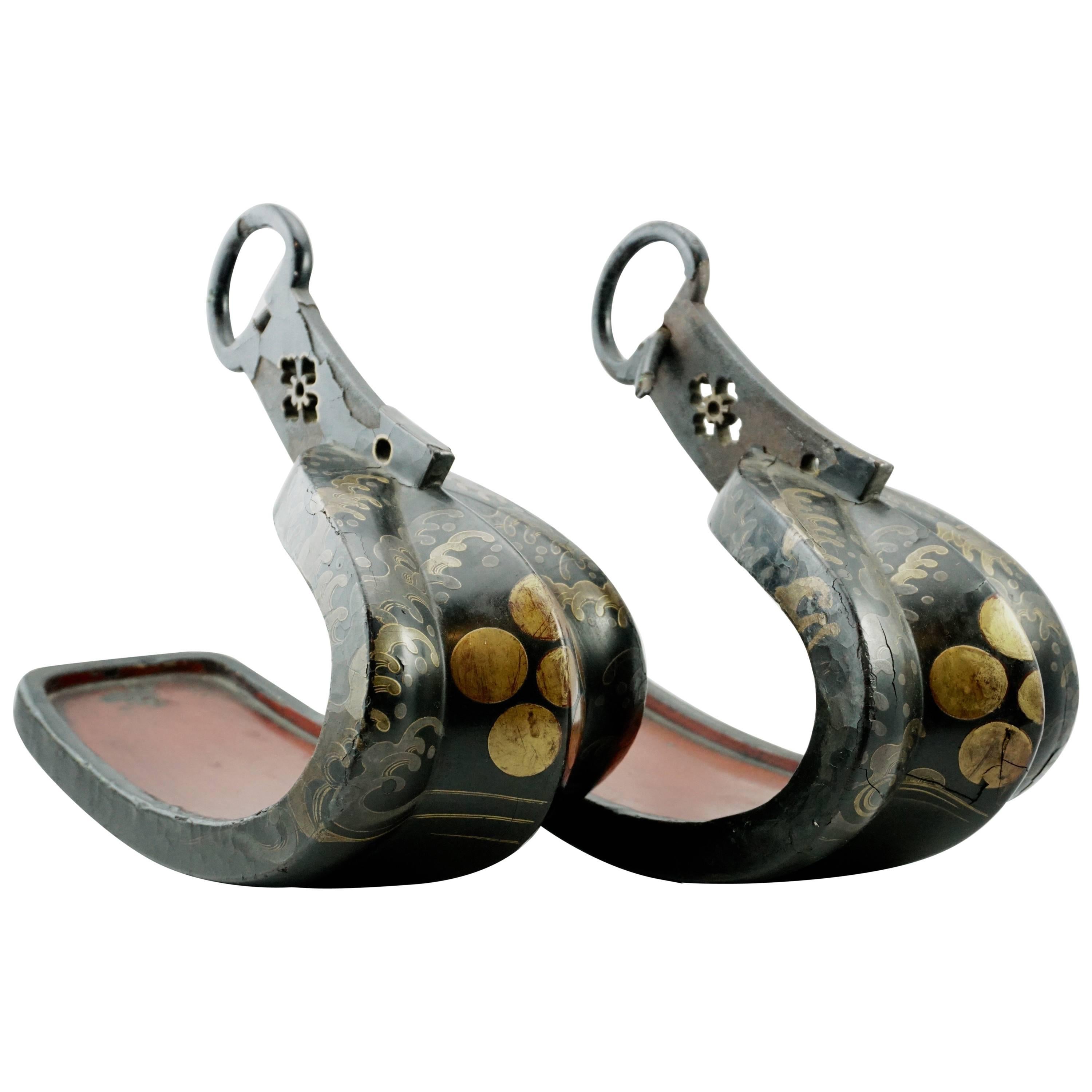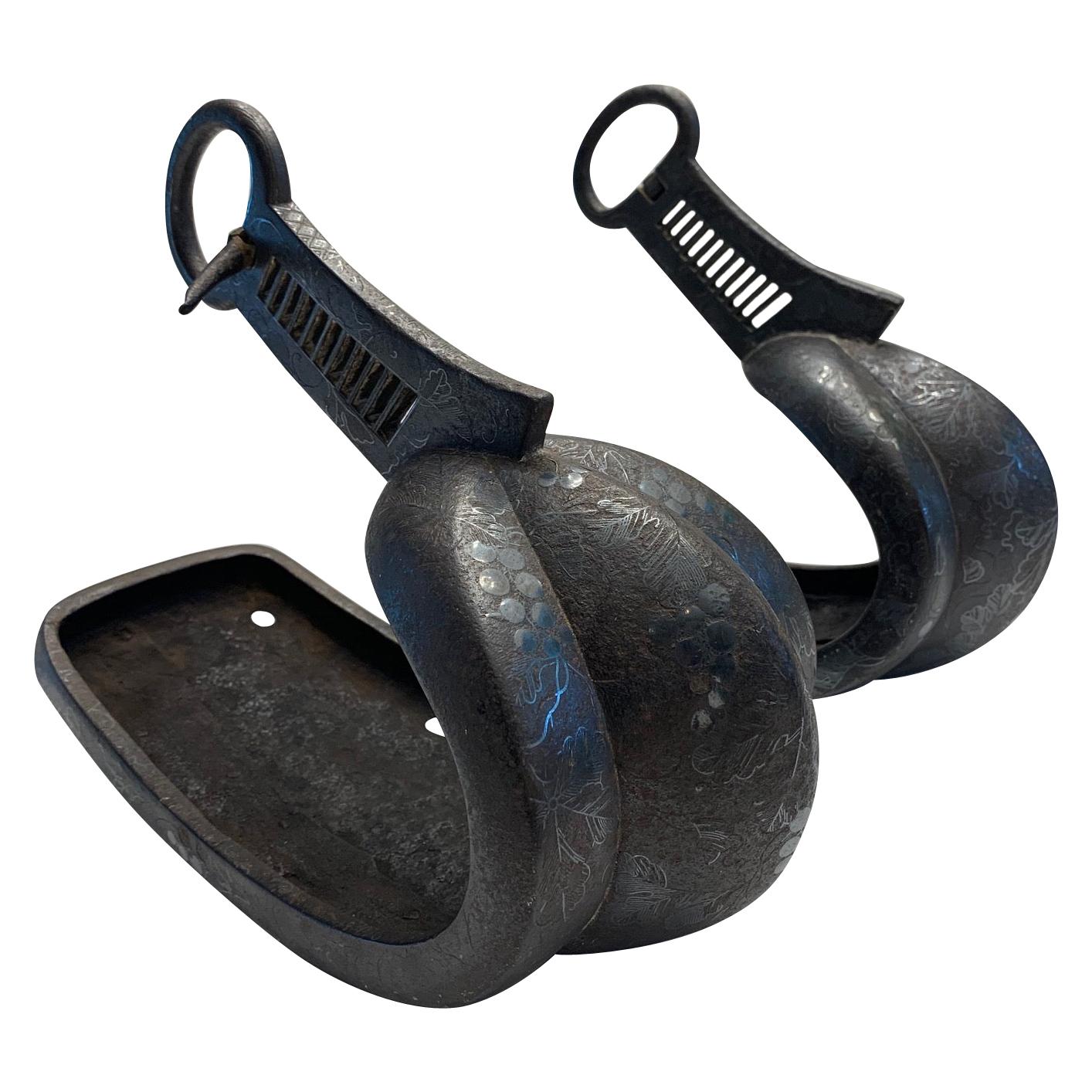Items Similar to 18th Century Japanese Silver Inlaid Iron Shogun Stirrup (Abumi) Red Lacquer
Video Loading
Want more images or videos?
Request additional images or videos from the seller
1 of 22
18th Century Japanese Silver Inlaid Iron Shogun Stirrup (Abumi) Red Lacquer
About the Item
18th century iron abumi of typical form, the stirrup inlaid in silver, an encircled peony flower crest surrounded with a geometric pattern, the interior retains the original wood lining decorated in red lacquer. The sides and underside also inlaid. Signed by the maker. Edo period.
This is a beautiful example of Japanese metalwork, sublime in it's design and craftsmanship, perhaps once belonging to a Shogun warrior. The perfect gift for the 'Shogun' fan.
11.5 inches wide, 10 high, 5 deep
- Dimensions:Height: 10 in (25.4 cm)Width: 11.5 in (29.21 cm)Depth: 5 in (12.7 cm)
- Style:Edo (Of the Period)
- Materials and Techniques:
- Place of Origin:
- Period:
- Date of Manufacture:1700
- Condition:Wear consistent with age and use.
- Seller Location:Stamford, CT
- Reference Number:1stDibs: LU803039595782
About the Seller
5.0
Platinum Seller
These expertly vetted sellers are 1stDibs' most experienced sellers and are rated highest by our customers.
Established in 1990
1stDibs seller since 2004
409 sales on 1stDibs
Typical response time: <1 hour
- ShippingRetrieving quote...Ships From: Stamford, CT
- Return PolicyA return for this item may be initiated within 14 days of delivery.
More From This SellerView All
- 19th Century Japanese Bronze Vase With Gilt Decoration, Meiji PeriodLocated in Stamford, CT19th century Meiji Period diminutive bronze vase with lovely etched and applied decoration. A raised gilt bird is shown flying above etched bamboo on one side, gilt applied lilies wi...Category
Antique Late 19th Century Japanese Meiji Metalwork
MaterialsBronze
- Pair of Japanese Brass CandlesticksLocated in Stamford, CTA fine pair of small beautifully made Japanese brass candlesticks with delicate silhouettes. The four curving legs on a round base supporti...Category
Antique Late 19th Century Japanese Meiji Metalwork
MaterialsBrass
- 19th Century Burmese Bronze Temple Bell with StandLocated in Stamford, CT19th century Burmese bronze temple bell with original carved hard wood stand, painted iron hanging bracket, and striker. This rare cast bronze bell has a splendid sculptural and spiritual presence. The bell has a long inscription on the upper part. The offering of a bronze bell to a monastery or temple was considered second only to the offering of a Buddha image as an act of merit (kutho). Such bells were cast using the lost wax (cire perdue) method. Casting of such bells was auspicious with specific rituals being performed by the caster and sponsors to ensure the appropriate blessings. The bell here, as with all such Burmese bells...Category
Antique Mid-19th Century Burmese Tibetan Metalwork
MaterialsBronze, Iron
- 19th Century Pair of Thai Bronze Hands of the Buddha, Abhaya and Vitarka MudrasLocated in Stamford, CTElegant pair of bronze hands of the Buddha displaying two ritual gestures, the Abhaya mudra, which represents protection, peace, benevolence, and t...Category
Antique Late 19th Century Thai Qing Metalwork
MaterialsBronze
- Indian Silvered Bronze Buddhist Deity Vajradhara Seated in Lotus PositionLocated in Stamford, CTWonderful small silvered bronze of Vajradhara. Indian, circa 1900. 7 inches high by 4 wide by 3 deep The Tibetan Buddhist deity Vajradhara is seated in a yogic meditation on a lotu...Category
Early 20th Century Indian Metalwork
MaterialsBronze
- Pair of 19th Century Spanish Colonial Carved Wood and Iron StirrupsLocated in Stamford, CTFantastic pair of 18th-19th century South American carved wooden stirrups. Known as estribos, each are carved from a solid block of wood. Decorated with wonderful carvings of horse heads and grape vines, these are truly charming pieces of Folk Art. With wrought iron stirrup rings and the original leather straps. Rich chocolate patina that only comes from age and use. Worn by Chilean 'huasos', highly skilled horsemen akin to America's cowboys. Prized by collectors of horse memorabilia...Category
Antique Early 19th Century Chilean Spanish Colonial Animal Sculptures
MaterialsWrought Iron
You May Also Like
- Pair of Japanese Edo Period Iron Silver Inlaid Red Lacquered Stirrups 'Abumi'Located in New York, NYA Pair of Japanese Edo Period (1603–1867) iron, silver inlaid, and red lacquered stirrups (Abumi). Each of typical form, made of iron with silver inlay on the front with floral bloss...Category
Antique 1690s Japanese Edo Metalwork
MaterialsSilver, Iron
- Pair of Japanese Abumi StirrupsLocated in PARIS, FRPair of stamped brass stirrups decorated with Hashizuka, Ito and Manabe Mons. Japan - Edo (1615-1868), 18th century. Height: 10.24 in. (26 cm), length: 12.6 in. (32 cm), width 4.72 in. (12 cm) As in Western culture, the culture Japanese stirrups were part of traditional accessories...Category
Antique Late 18th Century Japanese Metalwork
MaterialsBrass
- Japanese Samurai Abumi Stirrups Lacquer Edo, 18th CenturyLocated in Dallas, TXJapanese Samurai Abumi Stirrups lacquer Edo late 18th century, early 19th century. Measures: 12 inch length, 10 inch height, 5.5 inch width. AVANTIQUES is dedicated to providing an...Category
Antique Late 18th Century Japanese Edo Lacquer
MaterialsIron
- Pair of Japanese Abumi Samurai Stirrups with Dragons, c. 1800Located in Chicago, ILInlaid with brass and silver, this extraordinary pair of Japanese bronze stirrups, known as Abumi, were crafted in the Edo period (1603-1868) for use on a Samurai's horse. Each is wo...Category
Antique Early 19th Century Japanese Edo Metalwork
MaterialsSilver, Bronze, Iron
- Pair of 18th Century Japanese Edo Period Lacquered Samurai Iron StirupsLocated in Dallas, TX18th century Japanese Edo period Lacquered Samouri Iron stirups with original wooden lacquered insoles. Truly a beautiful pair of Japanese ...Category
Antique Late 18th Century Japanese Edo Metalwork
MaterialsIron
- Antique Japanese Iron Stirrups with Silver Inlay SignedLocated in Atlanta, GAA pair of antique Japanese Abumis, stirrup for horse-riding, in cast iron with elaborate silver inlay, circa 16th century Muramachi to Momoyama period. The prototype of Japanese abum...Category
Antique 16th Century Japanese Japonisme Metalwork
MaterialsSilver, Iron
Recently Viewed
View AllMore Ways To Browse
Antique Gift
Antique Gifts
18th Century Iron
Antique Japanese Silver
Japan Antique Silver
Japanese Antique Silver
18th Century Inlaid
Silver Inlaid
Inlaid Wood Art
Japan Iron
Japanese Iron
Japanese Fan Art
Antique Japanese Iron
Asian Wood Antique Red Lacquer
Japanese Warrior
Asian Fans
Japanese Hand Fan
Japanese Inlaid





